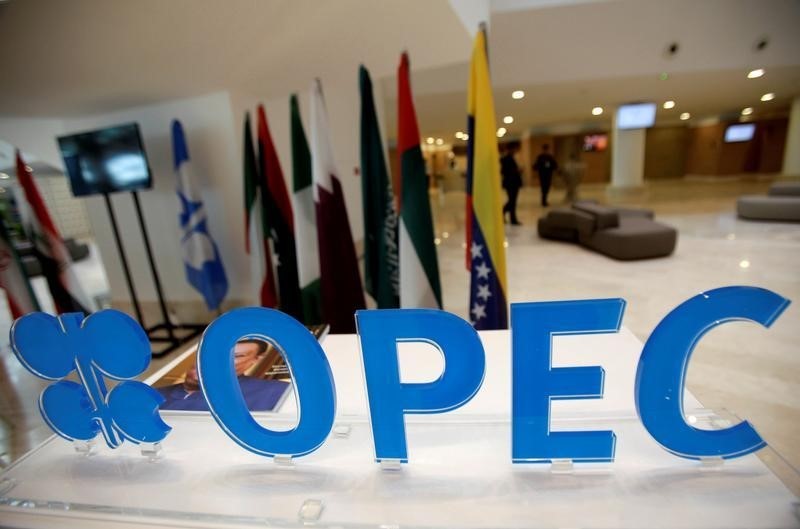Investing.com — Crude prices rose for the first time in three sessions on Thursday as bulls sought to steer the oil trade away from global economic worries that pushed it toward a second straight week of losses.
But gains were limited as data showed U.S. growth slowed more than expected in the first quarter despite resilient labor conditions that suggested more rate hikes to tame inflation.
New York-traded West Texas Intermediate, or , settled up 46 cents, or 0.6%, at $74.76 per barrel.
London-traded , the global benchmark for crude, finished up 68 cents, or 0.9%, at $78.37 per barrel.
WTI and Brent fell a cumulative 6% each over two previous sessions to head for a loss of about 4% this week, after last week’s slide of more than 5%.
The drop in crude prices came as global economic fears overwhelmed a burst of optimism created by a production maneuver announced by OPEC+ earlier this month to rescue an oil market that hit 15-month lows in March.
OPEC+, which groups the 13-member Saudi-led Organization of the Petroleum Exporting Countries with 10 independent oil producers, including Russia, said it will cut a further 1.7 million barrels from its daily output, adding to an earlier pledge from November to take off 2.0M barrels per day.
OPEC+, however, has a history of over-promising and under-delivering on production cuts. While the group achieved over-compliance on promised cuts in the aftermath of the 2020 coronavirus breakout, experts say that was more a result of battered demand that led to minimal production, rather than a will to cut barrels as pledged.
“The crude demand outlook is all over the place given the economy is hitting stall speed, while airliners still remain optimistic for a busy summer travel period,” Ed Moya, analyst at online trading platform OANDA, said.
U.S. economic data reinforced investor worries about a slowing economy with the Commerce Department reporting that real gross domestic product, or , grew at an annual rate of 1.1% in the first quarter of 2023 versus the 2.6% expansion in the fourth quarter of 2022. Economists tracked by Investing.com had expected a GDP growth of 2% for the first quarter.
U.S. fell unexpectedly by 16,000 last week to reach 230,000, the Labor Department reported Thursday in what would be another challenge to the Federal Reserve which needs unemployment numbers to rise to effectively fight inflation.
A consensus of economists had expected initial jobless claims to rise to 248,000 from the previous week’s revised level of 246,000. The drop reported by the Labor Department instead meant more inflationary pressure for the Fed to contend with.
To fight inflation, the Fed has added 475 basis points to rates in nine increases since March 2022. Rates now stand at a peak of 5%, compared with just 0.25% at the start of the coronavirus pandemic in March 2020. Another quarter-point hike is expected on , bumping up rates to a peak of 5.25%.
On the production front, OPEC got into a war of words with the International Energy Agency, or IEA, after the group which looks after the interests of oil consumers said surprise oil output cuts from OPEC+ risked exacerbating a projected supply deficit and could scupper an economic recovery.
In a Bloomberg TV interview on Wednesday, IEA Executive Director Fatih Birol warned that the Saudi-led OPEC should be “very careful” with its production policy, warning that the group’s short-term and medium-term interests appeared to be contradictory. He added that higher crude prices and upward inflationary pressures would result in a weaker global economy, with low-income nations likely to be disproportionately affected.
OPEC countered that the world’s leading energy authority should be “very careful” about undermining industry investments. The oil producing group’s Secretary General Haitham al-Ghais said finger-pointing and misrepresenting the actions of OPEC and OPEC+ was “counterproductive.” He added that the influential group of 23 oil-exporting nations was not targeting oil prices, but instead focusing on market fundamentals.
OPEC+ is also seething over an IEA call last year that oil markets were oversupplied, prompting the Biden administration to release a huge amount of crude from the U.S. reserve that pushed WTI to low $70 levels.
“The IEA knows very well that there are a confluence of factors that impact markets. The knock-on effects of COVID-19, monetary policies, stock movements, algorithm trading, commodity trading advisors and SPR releases (coordinated or uncoordinated), geopolitics, to name a few,” al-Ghais said.
Notwithstanding, al-Ghais’ ire, Russian Deputy Prime Alexander Novak said on Thursday that OPEC+ saw no need for further output cuts despite lower-than-expected Chinese demand for oil.
Read the full article here


